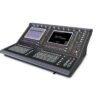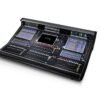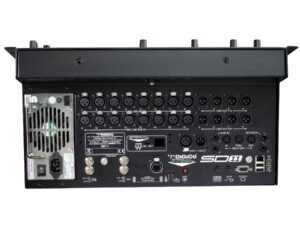DiGiCo QUANTUM 7B
DiGiCo QUANTUM 7B
Built to exceed the ambitions of tomorrow’s touring productions, Quantum 7 breaks the barrier of seventh generation FPGA technology to deliver a dramatic leap forward in power and connectivity. All of this can be added to your existing SD7 surface, ensuring rental partners benefit from an even longer return on investment.
The result is a revolution of possibilities that towers above every other mixing platform available today.
- 256 Input Channels
- 128 Aux / Sub-Group Busses
- LR/LCR/5.1 Master Buss
- 48 x 48 Full Processing Matrix
- 694 Dynamic Equalizers
- 48/96 kHz Sample Rate
WORKSURFACE
38 x 100mm touch-sensitive, motorised faders
14 x 60mm touch-sensitive, motorised faders
3 x 15” LCD high-resolution touchscreens
3 x Custom mounted LCD high-resolution TFT-LCD
Meterbridge screens
2 x ¼” Headphone sockets
1 x USB 2.0 slot
Integrated Light Bar
1 x 6.5” Meterbridge screen
1 x Meterbridge camera
1 x XLR Talkback input
REAR
2 x Redundant, hot-swappable PSUs
12 x XLR Mic/Line Inputs
12 x XLR Line Outputs
6 x XLR AES/EBU Inputs (12 x channels)
6 x XLR AES/EBU Outputs (12 x channels)
1 x GPI DSub37 (16 inputs) expandable to 32
1 x GPO DSub37 (16 outputs) expandable to 32
1 x MIDI In/Thru/Out (5 pin DIN) expandable to 2 sets
2 x Video BNC I/O
1 x RS422 port (9 pin)
1 x SMPTE I/O (XLR) plus level control
1 x XLR Talkback input
OPTIONS
Upgrade to Dual Loop Optocore (HMA, OpticalCon or ST)
Upgrade to SingleMode Optocore
GPIO/MIDI Expansion
Script Tray
Theatre Software
Broadcast Software
Flightcase
EX-007 Quantum Fader Expander
The DiGiCo Quantum 7 shall have 38 faders split into 3 worksurface sections, and two master faders. The left and the right worksurface sections shall have 6 layers of 6 banks. The centre worksurface section shall have an additional 14 faders (2 of which shall be master faders) on the upper section. The centre and the upper centre faders shall have 4 banks. All faders can be assigned to control any of the channel types. The console shall be capable of 256 input channels, 128 Aux/Sub-group Busses, a LR/LCR/LCRS/5.1 Master Buss, 36 VCA style or
mute group style Control Group channels, 2 Solo Busses, and a 48 input x 48 output full processing Matrix. All processing paths shall have full processing including Tube emulation, Dynamic EQ and Multiband Compression. Tube emulation, Dynamic EQ and Multiband Compression shall be available on every channel and Buss on the console. All processing shall be internal and FPGA-Based. An internal FX rack shall allow users to pick from 34 different FX. Up to 48 stereo FX can be added, compromising of 16 floating point reverbs and 32 delay/chorus/pitch/enhancer effects. An internal set of 48 32-band GEQs shall also be accessible. There shall be an additional processing Rack called the Spice Rack, allowing up to 16 mono effects. There shall also be 64 insertable Mustard Processing Strips. The position of these, and of inserts, shall be chosen from pre-processing, pre-EQ/dynamics, mid-EQ/dynamics, pre-fader or postfader. 256 instances of nodal processing shall also be available. These shall allow EQ and dynamics (including Dynamic EQ and Multiband Compression) to be applied to the aux node of a channel.
Three 15” (38cm) LCD high-resolution touch screens shall be provided to show the channel strips and the master screen on the centre screen. The two side screens shall each have a dedicated hardware channel strip, allowing control over filters, EQ, dynamics, insert points, aux sends and 5.1 panning. Each of the side screens shall also have 4 rows of rotary encoders to control various channel parameters. The master section to the right of the centre screen shall have physical controls to allow control over some snapshot functions, control over basic Solo functions, source and speaker selection (Broadcast software), control over the video feed and a button to control which engine is being viewed. There shall also be 8 layers of 5 user-assignable LCD macro buttons on the worksurface. The user shall also be able to program macros that can be triggered with fader movements, GPI, MIDI and keyboard functions. This master section shall also have a USB port. The console shall have three meterbridge screens to show channel metering. The meterbridge shall also have a meterbridge screen to show video feeds and a camera to send video of the user to other consoles.
The rear panel shall have 12 Mic/Line inputs, 12 line outputs, 6 AES/EBU inputs (12 channels) and 6 AES/EBU outputs (12 channels). It shall also have 1 DSub37 GPI and 1 DSub37 GPO (16 inputs and 16 outputs), MIDI In, Thru and Out, 2 sets of BNC Video I/O, an RS422 port, a set of XLR SMPTE I/O and an XLR talkback input. It shall also have 2 redundant and hot-swappable power supplies. Each engine shall have a MultiMode Optocore interface, providing 504 additional audio paths at 48kHz and 96kHz. The Optocore connection type shall be chosen from HMA, OpticalCon or ST. They shall also have a Waves port, 2 DMI slots, 4 switched ethernet ports, 8 sets of MADI I/O, giving up to 8 MADI interfaces or up to 4 redundant MADI interfaces at 48kHz or 4 interfaces at 96kHz, inbuilt UB MADI (USB Type B audio I/O interface for recording and playback of up to 48 channels), 2 USB ports, 2 DVI ports, external Wordclock I/O, AES sync and video sync.
There shall be option to add a second Optocore loop to each engine. This shall give an additional 504 audio paths at 48kHz and 96kHz. The Optocore interface can also be upgraded to SingleMode. There shall also be an option to expand the GPIO and MIDI of the console, adding another 16 inputs and 16 outputs, and a second set of MIDI In, Thru and Out ports. There shall be a Theatre Software option that shall provide Auto Update, Aliases, Players, Advanced CG programming tools and Matrix nodal delays. There shall also be a Broadcast Software option available that shall provide a Monitor Matrix, Backstop PFL and Mix Minus Busses.
Más productos DiGiCo
Productos relacionados
Digico
Digico
Digico
Digico
Digico
Digico
Digico
Digico














